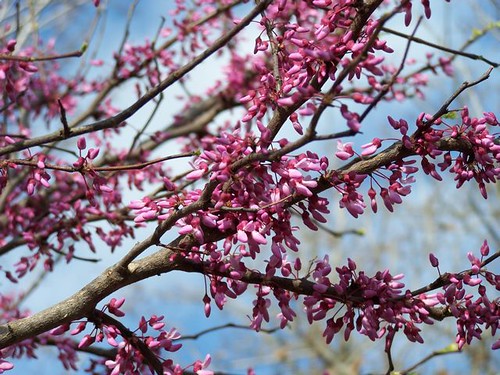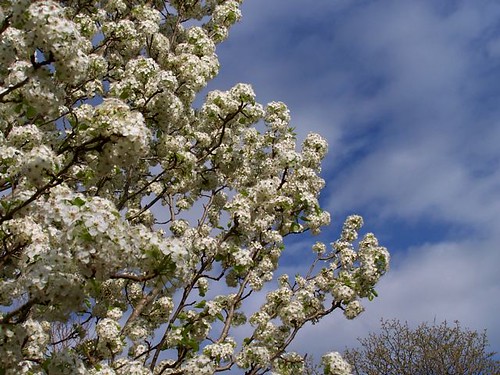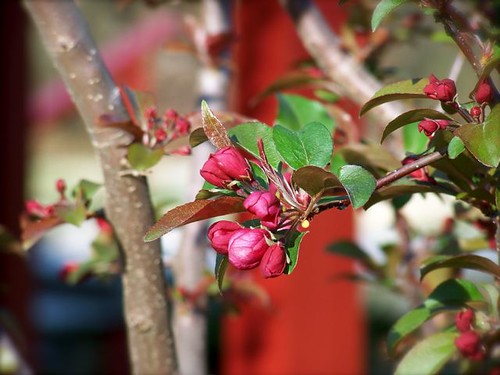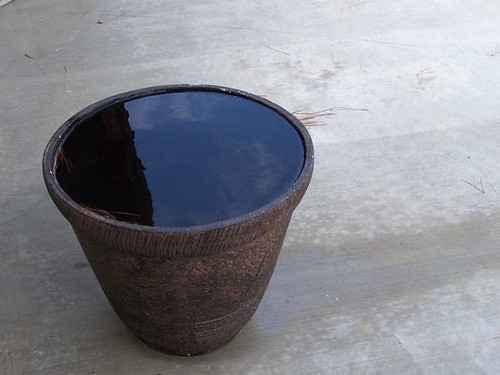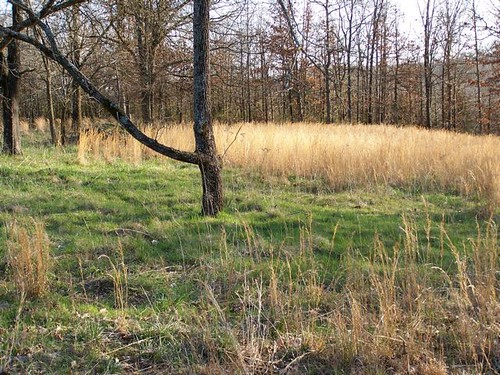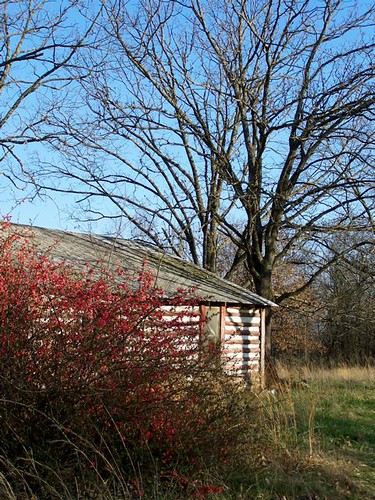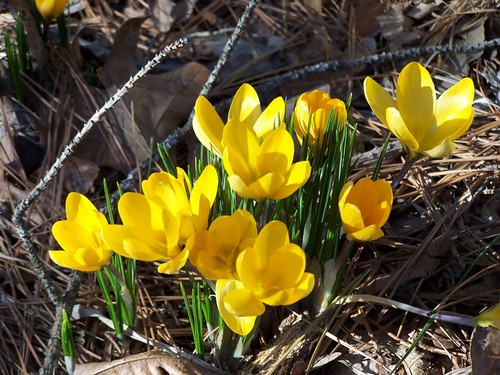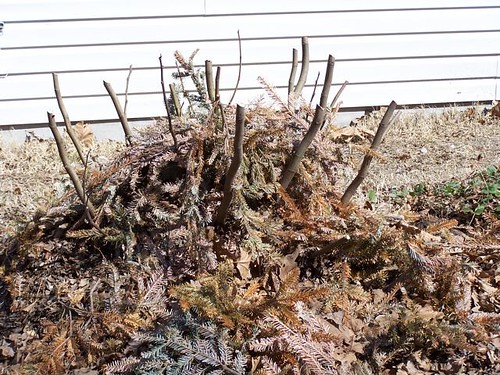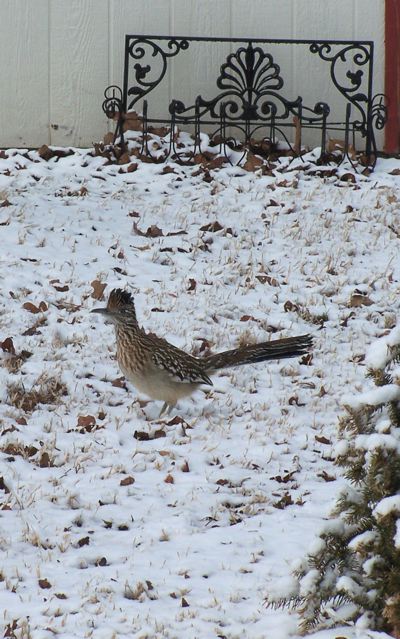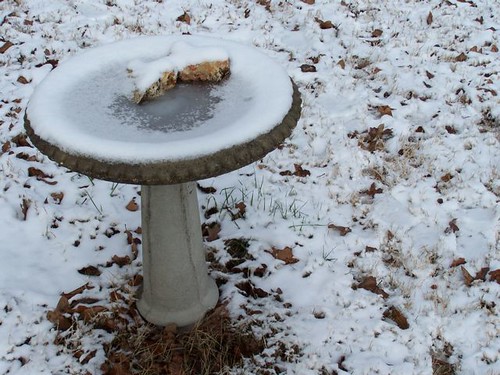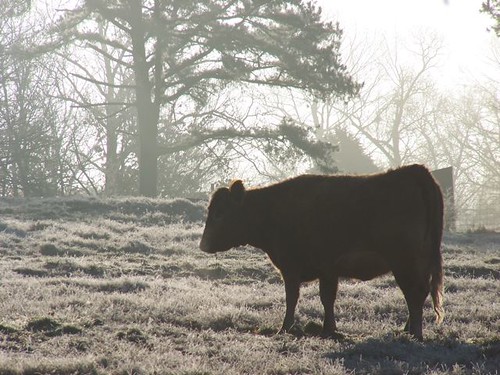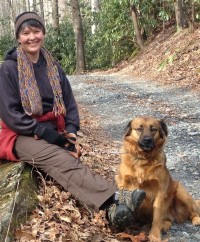"Five Apple Farm: Growing It Larrapin"
Geek adventures with honey bees, gardens & more on a Blue Ridge homestead
Wet Spring Garden Walk around Larrapin
I thought I’d take you along on the stroll we took today around the land. Ok, that makes it sound too tranquil. What really happened is it stopped pouring for a few hours and the sun came out yellow and bright. We grabbed galoshes and cameras and made a mad dash for the door!
Above is the view down the slope alongside the chicken paddock. I love it because the sun sets behind it and lights up the uncut grass and wildflowers under the trees. You can barely tell what it is, but the thin sticks in the front left is a clump of wild maples we brought home from my mother & father-in-law’s place. It has been so happy once we planted it in its new home.
Out front, the row of redbuds are beginning to put on their show, always an amazing shade of pinkish purple.
The ornamental pear is blooming and covered with pollinators of all kinds — bees, butterflies and little wasps (when it isn’t raining anyway). It’s not a Bradford Pear, but some kind of rangy early attempt at one I think. We’ve spared it — despite my feelings about Bradfords — because obviously the blooms are important to the pollinators. (And Mendy wouldn’t think of letting me take it out, even though it partially shades the veggies, because she loves it…)
Meanwhile, the “Prairie Fire” crabapple is getting ready for her amazing show. I love this tree! It was the very first tree we planted at Larrapin.
And the curly willow is greening up there beside one of the bird baths. Spring is greening! Thank goodness.
Now, if you notice I didn’t show the veggie garden, it’s because it’s not very pretty right now. I’ve got tarps and buckets and tools all over the place from last weeks’ digging frenzy. I’ll do photos once I get it cleaned up a bit! Thanks for joining me for a wet spring walk around Larrapin Garden.
Read MoreIn case you doubt it’s been raining here…
This is one of the new pots I bought for dwarf figs on the patio. Obviously I haven’t removed the plug from the drain hole and it was sitting underneath a place where the gutters overflow if it’s raining hard. This pot is thigh-high on me and it filled with water just from the thunderstorm last night. The ground is muck, the grass is greening and the farm ponds in the area are very, very full. Unfortunately, all this rain is exactly what the folks downstream don’t need at all right now. I was startled to read in the paper that nearly half the counties in Arkansas were declared disaster areas after the recent flooding (ours wasn’t among that group). But this explains why out of state friends and even out of the country friends called last week to “make sure we were ok.” It’s a good feeling to have people checking on your well-being! My thoughts go out to those folks who were not so lucky.
Read MoreSpring Down the Road
This captures the way an overgrown field in the Ozarks hills looks in mid-March. I love it.
Spring Down the Road – The Old Cabin
This is the wonderful falling-down cabin down the road from us. The flowering quince and tiny daffodils are still blooming, even as the walls tilt and the floors cave under. There is a cardinal guarding the quince, where the nest probably is hidden.
Read MoreSpring Tiptoed In..
This photo was from March 4th, but I’m just getting around to posting it. Since then there have been so many projects! New garden beds, new writing on native plants (more about that later), and oh, days and days of deluge and rain here in Arkansas. Lucky for us, we’re in the highlands of Northwest Arkansas, and if that weren’t enough, we’re on a particularly high and dry slope of a flat-topped mountain. It’s raining again today, so I’ll take this chance to post some things I’ve wanted to… Thanks for dropping by Larrapin Garden!
Read MoreWhat on earth is this you ask?
Ok, I admit I had never grown figs in a zone where it had to be cut back. Where I grew up in Alabama, the figs grew to the size of small trees and never had to be cut back for winter. Huge fig trees were a part of childhood and the house I grew up in had two huge figs on either side of the back door with their big raspy leaves and a shower of fruit every summer.
When I moved to the mountains of Western NC, I rarely saw figs except in pots. Now that Northwestern Arkansas is home, I see a few figs, but couldn’t help but notice they were fig “bushes” rather than trees. I even thought at first that there must be a different variety of figs grown up here.
But alas, that’s just what a fig looks like when the winters kill it to the ground every year and it grows back every year if you mulch it deeply. If it’s planted in a hot enough spot, and if the frosts come neither too late or too early (unlike 2007, when the frosts did just that) then you will have some figs.
This picture is our cut back fig bush covered with leaves and the remains of the Christmas tree. All are meant to protect the roots so it will grow back in the springtime. I don’t know why I left those fig-sticks rather than cutting if off to the ground. I guess the bama gal in me is in denial about this cutting back thing still…
This is Brown Turkey fig, the most cold hardy fig. But apparently my bit of Italian blood is showing b/c I’ve ordered some less hardy dwarf Italian figs and have already purchased big pots for our hottest patio to grow them in. I’m planning on putting them in the well-pump house for the winter, since we can’t let that freeze anyway.
I’ve read how the Italian communities of NY and the northeast do all sorts of bundling and potting tricks to keep their figs safe over the winter. I understand why. It feels wonderfully luxurious to pick a fig off the tree (let’s still call it a tree) and eat it right there in the yard. And so what that we only got to do that two or three times in 2007. (Which neatly polished off the total of about seven figs that survived the frosts.) OK, so not one fig made it inside the house. It was still worth it.
Read MoreCodeSample 4 up Flikr Pics




In late February, the sunlight is becoming beautiful. Even early in the morning it is bright and happy. I tried to find the best way to photograph it. Is it shadows or shine or refracted colors that capture it best? Whatever, its starting to feel nice
Yarden Walk: Late Winter…
We’ve had a LOT of precipitation around Larrapin garden this month. It’s come in every form: sleet, a little snow, icy rain… Today it’s just pure rain (with possible thunderstorms) and may stay gray and wet all weekend. So today in the blog we’ll take a winter walk from a couple of weeks ago and stroll around the grounds at Larrapin Garden…

One of the two blue chairs, under the white oak. I’m not sure how this oak came to be this way — a giant trunk and then multiple trunks off that. I’ve wondered if it was a cut tree that resprouted, or a cluster of acorns that grew up together and joined. She’s a lovely tree, with a sister tree a few yards away that is similarly shaped.
I love my blue metal chairs. They are such an emblem of home for me. This particular set came from my Grandmother, which makes them all the more dear. The blue chairs seem lovely to me whatever the season. In summer they beckon the gardener to bring a big glass of iced tea and admire the garden while rocking gently in the cool seats. In winter, they are a reminder that spring comes next in the cycling of the year…
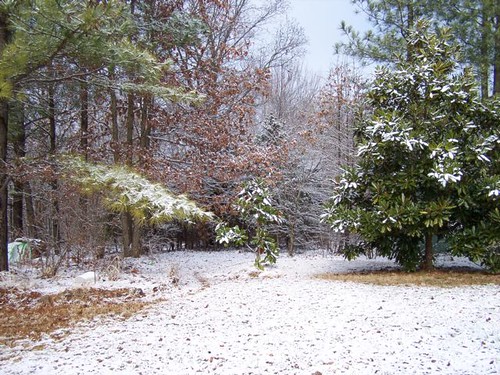
On the north side of the house there is this grouping of trees: pines and magnolias and everpresent oaks. The bigger magnolia on the right was here when we bought the place — artfully placed to block the back of a neighbor’s barn. (Even though it’s a lovely barn I’d love to have, we only see the back of it, so it’s ok to block it!) To continue the blocking job, we planted another one — the little one shown in the middle and I can’t think of the variety this moment– but it’s claim to fame is very soft fuzzy brown leaf underside that are just exquisite with the glossy green of the leaves. I also love the magnolia seedpods that fall on the ground looking rough and leathery, but closer inspection shows glossy red seeds, perfect as raindrops.
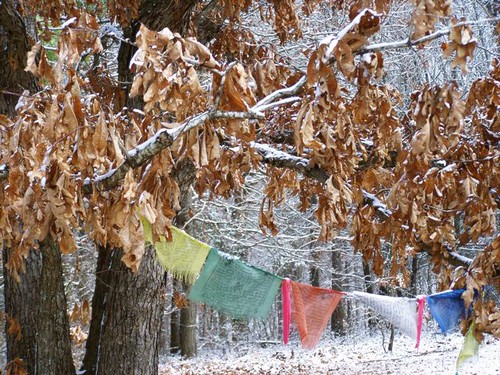
I’ll close with this view of the tattered remains of a prayer flag in the white oak. The string of prayer flags was a gift from my dear friend Marianne. They have been beautiful even as they fray and fade. The birds take some of the strings and I like to think of bird nests lined with prayer flags. Then I’ve started adding strips of red fabric with prayers written on them tied alongside the Tibetan ones. That’s a practice I plan to keep, even as I replace the flags that dissolve slowly in the weather..and that is how the prayers get prayed I think.
Hope you’ve enjoyed the winter walk. I have to credit “A Wildlife Gardener’s” blog post “Barleycorn in the Dead of Winter” for this post. Take a quick visit across the pond to visit her blog! Thanks for dropping by Larrapin Garden on a winter’s day.
Frost on young Blue Princess Holly

I love hollies because they have berries for the birds and deep green for the winter. Now that I’ve gotten all the visions of poor hollies shorn into bizarre and artificial globes out of my mind from those mall and suburban landscapes of childhood! I like hollies natural shaped and mixed closely with other shrubs. The American Hollies (not pictured) are particularly lovely — especially now that I’ve seen their true potential twenty or so years down the road after my visit to Bernheim Forest in Kentucky. They have dozens and dozens of hollies that are twenty, thirty feet tall, and most have the natural shape of an enormous Christmas tree — though some are more rangy and some are perfectly full.
I got lucky this past November and happened to catch the local Lowe’s during their plant clearance for the winter. At all but one Lowe’s, only a few straggling, struggling plants remained. But at the very newest one — the one the local folks aren’t used to being there — there were loads of shrubs still in great shape. (It drives me crazy when the big box stores don’t care for their plants and let them die in public en masse in the heat of the Arkansas summer. I can’t bear to go to our local Home Depot for this reason…) The sale had gone down to 75% off — so I packed my car with hollies and other evergreens — Nellie Stevens holly, Blue Princess holly, needlepoint holly, some juniper, a few old fashioned weigelias.
Now all that was before I read the book that has refigured my garden philosophy towards native plants. Larrapin Garden has always been about food for birds, butterflies, beneficials and us…but I had failed to understand the difference between making that food Ozark American vs. Chinese (so to speak). Wow, have my eyes been opened!
Bringing Nature Home (book review to come) is my new favorite book — the book I’d buy a whole case of and distribute to everyone I know if I could. After reading the wonderful book review over at A Study in Contrasts I want to review some of my favorite garden books here. Stay tuned. Thanks for visiting!
Morning Light, Frost and Neighbor Cow
This was the silvery view outside my studio door this morning.
Read More





